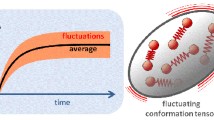Abstract
The theory for the deformation of a model macromolecule stretched by its ends under the action of high constant and low periodic forces is constructed. The macromolecule is composed of monomer units in three conformational states. The proposed theory describes the regime of a severe stretching of a macromolecule extended to a length close to its contour length, when its extension proceeds via conformational transitions between different states of monomer units. The structural parameters of the monomer unit are found to correlate with viscoelastic characteristics, which are calculated from the experimental results on the deformation of an individual macromolecule obtained by the frequency atomic force microscopy. For a monomer unit with three conformations, the force dependences of viscoelastic characteristics (effective coefficients of elasticity and friction) can show one or two minima. When the experimental dependences of the above parameters show two minima, the monomer unit can have three or more equilibrium states. With the knowledge of the viscoelastic characteristics of a macromolecule, it is possible to unequivocally estimate all structural parameters of a monomer unit for its three-state conformational model. When the force dependence of viscoelastic characteristics show only one minimum, the monomer unit can have two or more states and analysis of the corresponding viscoelastic characteristics at the minimum makes it possible to select between two- and three-state conformational models. Then, for the three-state model, experimental data allow the prediction of only equilibrium parameters of the monomer unit (position of the minima and energy); dynamic parameters (positions and height of barriers between equilibrium states) remain indeterminate. The proposed theory is used for the interpretation of the viscoelastic characteristics of dextran obtained by single-molecule AFM experiments. The three-state conformational model of a dextran unit is shown to agree better with the experimental data than with the two-state conformational model.
Similar content being viewed by others
References
Noncontact Atomic Force Microscopy. NanoScience and Technology, Ed. by S. Morita, R. Wiesendanger, and E. Meyer (Springer, Heidelberg, 2002).
F. Giessibl, Rev. Mod. Phys. 75, 949 (2003).
M. O. Gallyamov, B. Tartsch, P. Mela, et al., Phys. Chem. Chem. Phys. 9, 346 (2007).
K. Mitsui, M. Hara, and A. Ikai, FEBS Lett. 385, 29 (1996).
E. Evans and K. Ritchie, Biophys. J. 72, 1541 (1997).
M. Rief, M. Gautel, F. Oesterhelt, et al., Science (Washington, D. C.) 276, 1109 (1997).
M. Rief, F. Oesterhelt, B. Heymann, and H. Gaub, Science (Washington, D. C.) 275, 1295 (1997).
P. Marszalek, A. Oberhauser, Y. Pang, and J. Fernandez, Nature (London) 396, 661 (1998).
H. Li, M. Rief, F. Oesterhelt, and H. Gaub, Adv. Mater. (Weinheim, Fed. Repub. Ger.) 10, 316 (1999).
M. Rief, J. Fernandez, and H. Gaub, Phys. Rev. Lett. 81, 4764 (1998).
M. Rief, H. Clausen-Schaumann, and H. Gaub, Nat. Struct. Biol. 6, 346 (1999).
P. Marszalek, H. Li, A. Oberhauser, and J. Fernandez, Proc. Natl. Acad. Sci. U. S. A. 99, 4278 (2002).
T. E. Fisher, P. E. Marszalek, A. F. Oberhauser, et al., J. Physiol. 520, 5 (1999).
H. Clausen-Schaumann, M. Rief, C. Tolksdorf, and H. E. Gaub, Biophys. J. 78, 1997 (2000).
D. Anselmetti, J. Fritz, B. Smith, and X. Fernàndez-Busquets, Single Mol. 1, 53 (2000).
F. Kienberger, V. Ph. Pastushenko, G. Kada, et al., Single Mol. 1, 123 (2000).
H. Li, W. Zhang, X. Zhang, et al., Macromol. Rapid Commun. 19, 609 (1998).
C. Ortiz and G. Hadziioannou, Macromolecules 32, 780 (1999).
M. Kawakami, K. Byrne, B. Khatri, et al., Langmuir 20, 9299 (2004).
B. S. Khatry, PhD Thesis (Univ. Leeds, Great Britain, 2006).
K. A. Walther, J. Brujie, H. B. Li, and J. M. Fernandez, Biophys. J. 90, 3806 (2006).
I. Neelov, D. Adolf, M. Ratner, et al., Macromol. Symp. 237, 81 (2006).
I. Neelov, D. Adolf, T. McLeish, and E. Paci, Biophys. J. 91, 3579 (2006).
I. Neelov, D. Adolf, and T. McLeish, Lect. Notes Comput. Sci. 3980, 711 (2006).
I. Neelov, D. Adolf, and T. McLeish, Macromol. Symp. 252, 140 (2007).
S. Chandrasekhar, Stochastic Problems in Physics and Astronomy (Rev. Mod. Phys. 15, 1 (1943); Inostrannaya Literatura, Moscow, 1960).
Author information
Authors and Affiliations
Corresponding author
Additional information
Original Russian Text © D.A. Markelov, I.M. Neelov, A.I. Neelov, Yu.Ya. Gotlib, A.A. Darinskii, 2009, published in Vysokomolekulyarnye Soedineniya, Ser. A, 2009, Vol. 51, No. 8, pp. 1498–1515.
This work was supported by the Russian Foundation for Basic Research (project nos. 08-03-00150 and 08-03-00565); the federal target program Integration; the Division of Chemistry and Materials Sciences, Russian Academy of Sciences, under the program Development and Study of Macromolecules and Mac-romolecular Structures of New Generations; INTAS (grant no. 05-1000004-7747); and the EPSRC, EP/C528336/1.
Rights and permissions
About this article
Cite this article
Markelov, D.A., Neelov, I.M., Neelov, A.I. et al. The theory of viscoelastic characteristics of a highly stretched macromolecule in single molecule AFM. Polym. Sci. Ser. A 51, 940–956 (2009). https://doi.org/10.1134/S0965545X09080148
Received:
Revised:
Published:
Issue Date:
DOI: https://doi.org/10.1134/S0965545X09080148




